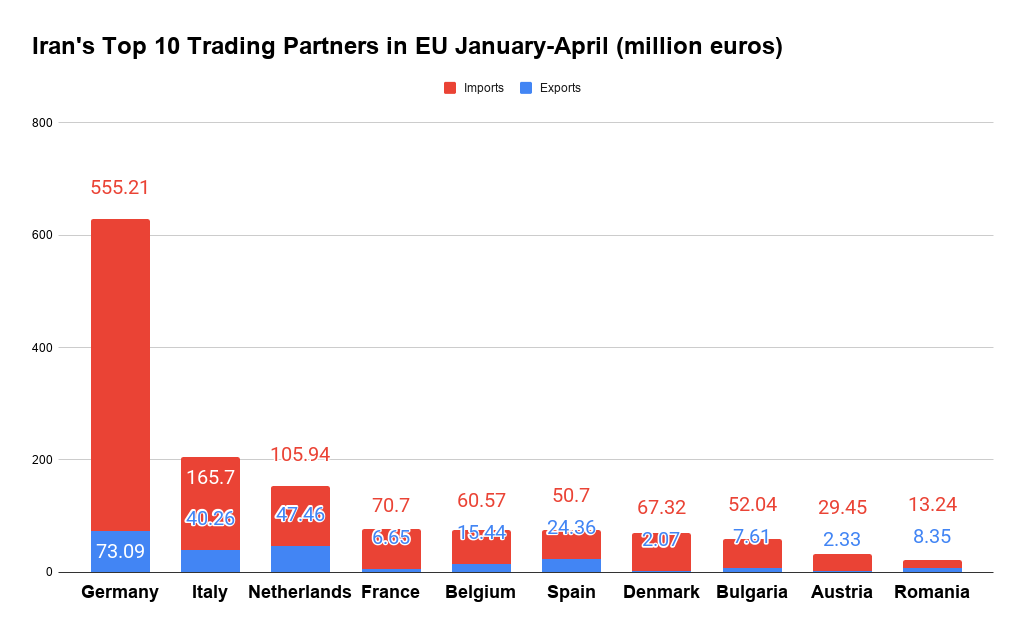Iran’s Trade With EU Surpasses €1.4 Billion in 4 Months
Trade between Iran and EU member states during January-April stood at €1.47 billion to register a 2.5% decline compared with last year’s corresponding period, latest data provided by the European Statistical Office show.
Germany, Italy and the Netherlands were Iran’s top three trading partners in the European bloc with bilateral exchanges standing at €628.3 million (up 26.45% YOY), €205.96 million (down 22.09% YOY) and €153.41 million (up 20.35% YOY), respectively.
Iran’s trade with Luxembourg (€674,468), Slovakia (€4.34 million) and Bulgaria (€59.66 million) increased by 850.93%, 142.96% and 116.60% respectively year-on-year—the highest among EU states.
Trade with Malta (€1,536), Finland (€1.88 million), Ireland (€4.19 million), Romania (€21.59 million) and Sweden (€11.44 million) saw the sharpest declines of 98.96%, 82.13%, 78%, 67.68% and 63.67% respectively.

Eurostat is a directorate of the European Commission located in Luxembourg. Its main responsibilities are to provide statistical information to EU institutions and promote the harmonization of statistical methods across its member states and candidates for accession.
Organizations in different countries that cooperate with Eurostat are summarized under the concept of the European Statistical System.
Exports Rise 4.73%
Iran exported €245.5 million worth of commodities to the EU during the four-month period, indicating a 4.73% rise compared with the similar period of the previous year.
The main export destinations over the period were Germany (€73.09 million), the Netherlands (€47.46 million), Italy (€40.26 million), Spain (€24.36 million) and Belgium (€15.44 million).
Iran’s exports to Luxembourg (€365,608), the Netherlands (€47.46 million) and Finland (€743,766) experienced the highest year-on-year growth rates of 1,161%, 641.35% and 185.43% respectively.
This is while exports to Malta (none), Czech Republic (€143,155) and Hungary (€575,053) fell by 100% (from €27,794 in the corresponding period of 2019), 67.37% and 64.75% YOY respectively, which are the sharpest among EU member states.
The exported goods mainly included edible fruit and nuts; peel of citrus fruits or melons worth €79.17 million; mineral fuels, mineral oils and products of their distillation, bituminous substances and mineral waxes with €41.75 million; plastics and articles thereof worth €23.12 million; coffee, tea, maté and spices worth €16.46 million; iron and steel worth €11.30 million; pharmaceutical products worth €8.8 million; fertilizers worth €8.48 million; carpets and other textile floor coverings worth €7.32 million; lac, gums, resins and other vegetable saps and extracts worth €7.28 million; iron and steel products worth €6. 12 million and nuclear reactors, boilers, machinery and mechanical appliances worth €4.88 million.
Imports Fall 3.82%
Imports from the EU dropped by 3.82% to stand at €1.22 billion during the four months under review.
The top five exporters from the European bloc to Iran were Germany with €555.21 billion, Italy with €165.70 million, the Netherlands with €105.95 million, France with €70.70 million and Denmark with €67.33 million worth of shipments to Iran.
Exports of Luxembourg worth €308,860, Bulgaria €52.04 million and Slovakia €2.61 million to Iran saw highest YOY increase (636.54%, 258.94% and 201.07% respectively).
Malta with €1,536, Finland with €1.138 million and Ireland with €4.058 million experienced the sharpest YOY decline in exports to Iran (98.71%, 88.92% and 78.71% respectively).
The imports mainly included nuclear reactors, boilers, machinery and mechanical appliances, as well as parts thereof worth €257.77 million; cereals worth €233.66 million; pharmaceutical products worth €147.51 million; optical, photographic, cinematographic, measuring, checking, precision, medical or surgical instruments and apparatus, as well as parts and accessories thereof worth €115.82 million; electrical machinery and equipment and parts, sound recorders and reproducers, television image and sound recorders and reproducers, and parts and accessories of such articles worth €47.74 million; oilseeds, oleaginous fruits, miscellaneous grains, seeds, fruit, industrial or medicinal plants, straw and fodder worth €37.37 million; miscellaneous chemical products worth €31.88 million; railroad or tramway locomotives, rolling-stock and parts thereof, railroad or tramway track fixtures, fittings and parts thereof, mechanical (including electro-mechanical) traffic signaling equipment of all kinds with €25.69 million; organic chemicals worth €25.26 million; plastics and articles thereof worth €21.94 million; and manmade staple fibers worth €18.79 million.
Other imported products included miscellaneous edible preparations worth €17.25 million, essential oils, resinoids, perfumery, cosmetic or toilet preparations worth €16.67 million; tanning or dyeing extracts, tannins and their derivatives, dyes, pigments and other coloring matter, paints and varnishes, putty and other mastics, as well as inks worth €16.26 million; paper, paperboard, articles of paper pulp, paper or paperboard worth €10.97 million; albuminoidal substances, modified starches, glues and enzymes with €9.95 million; residues and waste from the food industries and prepared animal fodder with €8.92 million; dairy produce, birds’ eggs, natural honey, edible products of animal origin, not elsewhere specified or included worth €8.12 million; and live animals worth €8.06 million.
Monthly Perspective
Bilateral trade in April stood at €313.355 million to register a drop of 8.72% compared to April 2019.
Germany, Italy and the Netherlands were Iran’s top three trading partners in April with commercial exchanges standing at €141.72 million, €34.13 million and €25.68 million respectively.
Iran’s trade with Luxembourg (€186,450), Portugal (€4.13 million) and Bulgaria (€15.93 million) increased by 111,546.71%, 385.44% and 148.72% respectively year-on-year—the highest among EU states.
Trade with Malta (none), Cyprus (none) and Finland (€8,063) saw the sharpest declines with the first two observing a 100% fall from €18,787 and €441,467 in April 2019 respectively and the third one experiencing a 99.66% decline.
Iran exported €19.88 million worth of commodities to the EU in April, indicating a 64.84% fall compared with last year’s April.
The main export destinations in April were Germany (€6.11 million), Italy (€4.09 million) and Greece (€2.44 million),
Iran’s exports to Portugal, Luxembourg and Greece experienced the highest year-on-year growth rates of 2,636.79%, 1,138.32% and 126.12% respectively.
This is while exports to Hungary, Ireland and Slovenia fell by 99.06%, 95.48% and 94.77% YOY respectively, which are the sharpest among EU member states.
Imports from the EU increased by 2.36% to stand at €293.47 million during April.
The top three exporters from the European bloc to Iran were Germany with €135.61 million, Italy with €30.04 million and the Netherlands with €25 million worth of shipments to Iran.
Bulgaria with €15.08 million, Portugal with €4.07 million and Slovakia with €988,687 were the EU countries whose exports to Iran saw a highest YOY increase (439.61%, 379.68% and 318.9% respectively).
Finland with €7,060, Romania with €32,675 and Ireland with €304,641 experienced the sharpest YOY decline in exports to Iran (99.7%, 98.88% and 85.98% respectively).
To see the source click here.

